This post is adapted from the blog of LendEDU, a Priceonomics Data Studio customer. Does your company have interesting data? Become a Priceonomics customer.
***
Your college years may be the best ones of your life, but they can also be the most expensive.
Many of today’s students are financing their education with loans, and are graduating with more debt than ever. In fact, the student debt in the US is estimated at $1.4 trillion, more than what Americans owe on credit cards or cars. Saddled with loans, college graduates are having trouble saving for retirement, starting businesses, and even keeping up with daily expenses.
We wanted to know just how much hindrance student debt is causing today’s graduates, and which groups are affected the most. And does student debt have a differential impact by gender or race?
To answer these questions, we analyzed data from Priceonomics customer LendEDU, who surveyed over 1,400 college graduates between the ages of 25 and 54 to learn more, we found that on average, people graduate college with nearly $40,000 in debt and that men have more debt than women. We also discovered that white and asian college graduates have more debt than their black and hispanic/latino peers.
When it comes to financing their education, men tend to get more help from the parents in paying for college than women do. And, among all the demographic groups we survey, Asian students get the most financial help from their parents in paying for college by far. However, Asians are more likely to feel the pressure of student debt preventing them from starting businesses compared to their peers.
***
We first wanted to see how much debt on average afflicted a college graduate. We started off by examining the average student loan debt upon graduation as well as the survey respondents’ average current loan balance.
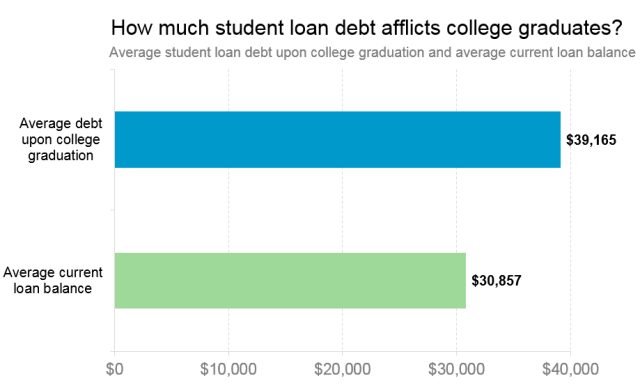
Data source: LendEDU
On average, survey respondents graduated with nearly $40,000 in debt and still have about $30,000 left to pay off of the loan. This means that even years later (since all of our respondents were at least 3 years out of school) college graduates still have an average of 75% of their loans left to pay.
We then wondered if the average student loan debt varied by race or gender. We divided the population by gender as well as into 4 racial categories (white, black, hispanic/latino, and asian) based on how the survey participants self identified.
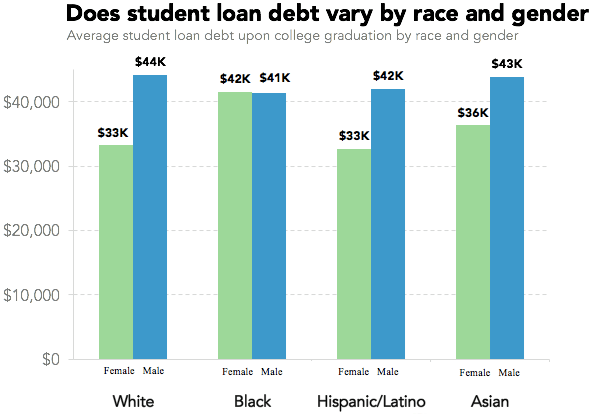
Data source: LendEDU
There is a wide range of average debt upon graduation between the genders and races. White college students have the biggest discrepancy between male and female graduates. On average, white male students graduate with about 33% more debt than their white female peers. Interestingly, white males graduate with the most debt of any of our subgroups, and white females graduate with the second least amount of debt. As a whole, females tended to graduate with less debt than their male counterparts, except for black females who had $272 more in debt than black males. Asian males graduated with the second most debt, just $253 on average less than white males. On the other side, hispanic/latino women graduated with the least amount of debt; they have $564 less to pay off than white women.
In today’s era with skyrocketing college costs, many people receive financial help from their parents. We wanted to know how much assistance our survey respondents received.

Data source: LendEDU
Nearly half of the college graduates we surveyed paid for college without any assistance. Only about 10% received about half their tuition from their family. Fewer than one in ten people had the majority of their college finances supported by their parents.
We next wondered how much this financial assistance varied by gender. Since the average amount of debt was smaller for women, was this because they were getting more financial help?

Data source: LendEDU
Overall, females receive less help paying for college than their male peers.
Only 6% of women responded indicating that their parents paid for the majority of the tuition, and 50% received no help at all. On the other hand, only 43% of male respondents said their parents did not contribute financially to their schooling. Additionally, one in ten male respondents said their parents paid the majority of their college tuition, nearly double the number of women who answered the same way. This is particularly noteworthy after we saw above on a whole women graduate with less debt than men. So even though they get less financial help from their families, women still have fewer loans to repay after college.
We were then curious to see if familial financial assistance for college varied by race. Again we broke the survey respondents into the same four racial categories based on how they self identified.
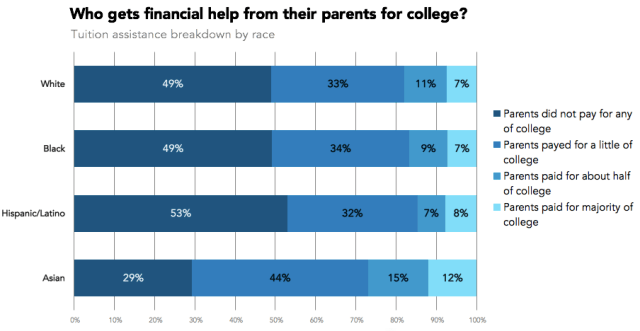
Data source: LendEDU
Just as we saw when we examined the question by gender, there is a large difference in family tuition assistance when we break the responses down by race. About half as many asians as whites, blacks, or hispanics/latinos said they received no money from their parents towards college.
The most clear finding, however, is that Asians get the most financial help from their parents paying for school. Nearly double the number of asian respondents reported getting the majority of their college tuition paid for by their parents compared to the other races.
Finally, we wanted to explore how student debt affected people in the years after graduation. Did our respondents feel hindered in any way by their outstanding loans and did this sentiment vary by gender?
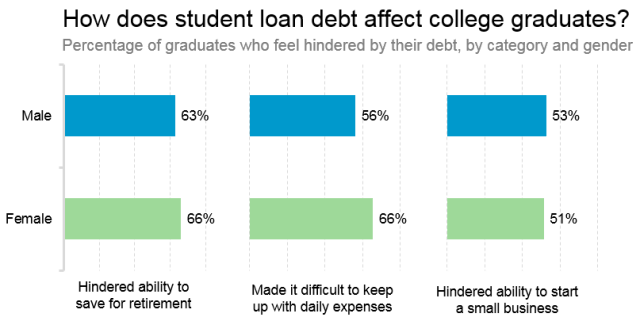
Data source: LendEDU
On the whole, more than half of the respondents of both genders felt that their debt negatively impacted their current lives. Nearly two thirds of respondents said their current loans have made it harder to save for retirement, and over 50% said that the debt has made starting a small business more difficult.
The place where we see the biggest difference in these feelings by gender is in the respondent’s’ feelings about keeping up with daily expenses. Only about half the men said that their debt has made day-to-day finances more burdensome, but 10% more females felt the same way.
Again, we wanted to examine this angle from a racial demographic standpoint. We know that each race graduates with differing levels of debt, but do they also feel unequally burdened by it?
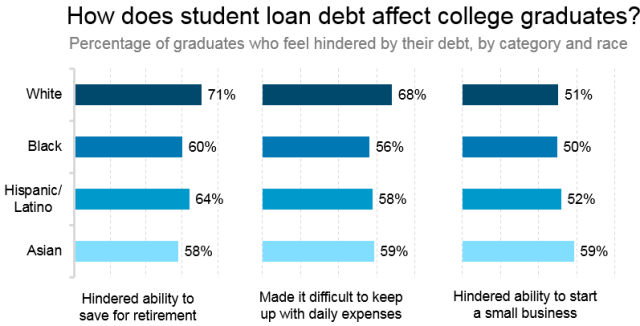
Data source: LendEDU
White respondents, more than the other races, felt the most strongly that their student debt hindered their ability to save for retirement and keep up with daily expenses. For example, 13% more white college graduates than asian graduates think their loans have negatively impacted their retirement savings. However, asian respondents feel the most burdened by their debt when it comes to their ability to create their own company. Almost 10% more asian graduates than any other race felt their loans hindered their ability to start a small business.
***
With an average student graduating with $39,165 in debt, all students across the US are feeling the pain of financing their education. But not all groups are burdened equally. We saw that women tend to have less debt than men, despite getting less financial help from their parents. Additionally, white men and asian men graduate with the largest loans, whereas white women and hispanic/latino women have the least. Finally, women disproportionately feel that their debt makes it difficult to keep up with daily expenses, and asians have the most trouble starting small businesses in the face of their loans.
***
Note: If you’re a company that wants to work with Priceonomics to turn your data into great stories, learn more about the Priceonomics Data Studio.




